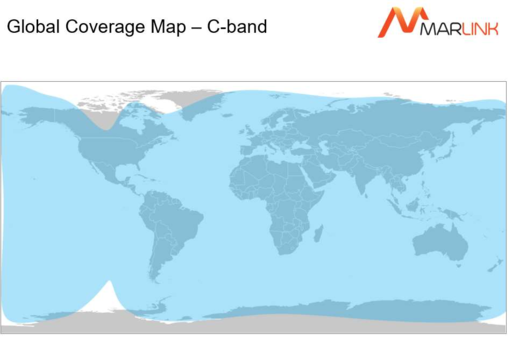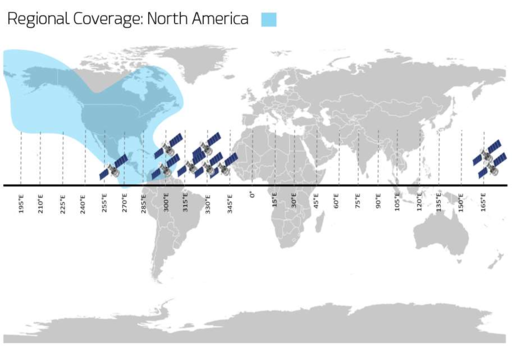Sealink¶
Provider details at:
- https://marlink.com/products/sealink-customized/
- https://marlink.com/products/sealink-plus/
- https://marlink.com/products/sealink-premium/
Sealink is Marlink’s commercial service that offers service that is comparable to HiSeasNet. We generally buy Sealink Plus for vessels, though there are some legacy Sealink (sans Plus) systems in in need of upgrade as of 2020.
Any Sealink service has some notable difference from the HiSeasNet service:
- The Sealink service can use spectrum on many satellites. When used, vessels generally have an easier time of staying online as a result, especially when there are notable blackage zones in the ship’s installation. That said, part of this process involves frequent upkeep by Marlink, so extended system downtime can require manual intervention if your ship is moving locations while this is going on.
- Nominal Sealink uses Time-division multiple access (TDMA) instead of Single channel per carrier. This can result in more jittery network performance and some bandwidth limits we may run into at the extreme levels of performance. For currently funded nominal service, this is not a show-stopper, but the savvy user may notice the difference and TDMA may have to be eschewed for high-performance events.
- As hinted in the previous point, high-performance expansions may be significantly more involved. 90 days or more notice is needed to determine equipment requirements and capacity availability.
Bandwidth¶
HiSeasNet has pre-negotiated rates for Sealink, available on Ku-band regional, Ku-band global and/or C-band global. It is possible to contract higher performance, subject to availability; these are merely data plans that are easy to request.
All Committed Information Rate (CIR) and Maximum Information Rate (MIR) units are in Kilobits Per Second (kbps).
When planning, one should plan for the CIR. MIR throughput typically only happens over a few seconds and should generally not be expected to last for very long.
Since most people tend to think in terms of MegaBytes, note that one MegaByte is 8192 kilobits.
| CIR shore-to-ship | CIR ship-to-shore | MIR shore-to-ship | MIR ship-to-shore | Notes |
|---|---|---|---|---|
| 512 | 256 | 1024 | 512 | Nominal plan for vessels with less than 40 berths (Q1 2020 to ~Q1 2022). |
| 1024 | 512 | 4096 | 1024 | Nominal plan for vessels with 40 berths or more (Q1 2020 to ~Q1 2022). |
| 2048 | 1024 | 6144 | 2048 | — |
| 2048 | 2048 | 6144 | 2048 | Nominal plan for 1.5m radome-equipped ARF vessels (beginning Q4 2021-Q1 2022) |
| 4096 | 2048 | 8192 | 4096 | Nominal plan for 2.4m radome-equipped ARF vessels (beginning Q4 2021-Q1 2022) |
Note that, with high-performance shipboard equipment, planning and funding, it is possible to operate Sealink at up to 80 Mbps via Sealink Customized.
Frequencies¶
Sealink uses IEEE C-band and Ku-band frequency ranges.
Coverage Maps¶
Global¶


Regional¶





Suspensions¶
Note
Satellite-based Internet is very expensive, so suspending plans when feasible can greatly reduce overall operating costs. Reducing those costs mean less expenditure to our funding agencies and less overall expense in ships’ day rate(s).
We encourage all participants to contact us when/if you are aware that your ship will be laid up for an extended period of time and a terrestrial network connection is available.
Suspension duration should typically be for at least 1 month. A start date and end date is needed to make the request, and this can be adjusted if need be. Typical request processing can take a full business week to request or change.
It is possible to suspend this plan. Our contract allows for up to 25% of the year in suspended mode.
Voice¶
Note
Sealink VoIP phones cost the least to use, on average. Please prefer this phone over others.
Specifically, Sealink phones are cheaper when calling: Alaska, Algeria, Andorra, Argentina, Australia, Austria, Bahrain, Bangladesh, Belgium, Bermuda, Bolivia, Brazil, Brunei, Bulgaria, Burundi, Cambodia, Canada, Chile, China, Colombia, Costa, Rica, Croatia, Cyprus, Czech, Rep, Denmark, Dominican, Rep, Estonia, Faroe, Finland, France, Germany, Gibraltar, Greece, Guadeloupe, Guam, Guiana, French, Hawaii, Hong, Kong, Hungary, Iceland, India, Indonesia, Iran, Iraq, Ireland, Israel, Italy, Jamaica, Japan, Jersey, Kazakhstan, Kenya, Korea, South, Laos, Latvia, Lithuania, Luxemburg, Macau, Malaysia, Malta, Martinique, Mexico, Monaco, Mongolia, Morocco, Mozambique, Namibia, Netherlands, New, Zealand, Nigeria, Norway, Pakistan, Panama, Paraguay, Peru, Poland, Portugal, Puerto, Rico, Reunion, Romania, Russia, Saipan, Samoa (American), Singapore, Slovakia, Slovenia, South, Africa, Spain, Swaziland, Sweden, Switzerland, Taiwan, Thailand, Turkey, United, Kingdom, Uruguay, USA, Uzbekistan, Venezuela, Vietnam, Virgin isl, US, or Zambia
Fleet Xpress VoIP phones can be double cost to use compared to Sealink VoIP, but have the advantage of being available via Global Xpress or FleetBroadband. Fleet Xpress is also available on all ships we support, whereas Sealink may not be.
The phone(s) plugged into the FleetBroadband unit are the most expensive to use.
Sealink comes with a couple VoIP voice lines. Ship use of ~100 hours per month is expected to be covered by our project. Heavier use may need to be evaluated on a case-by-case basis.
